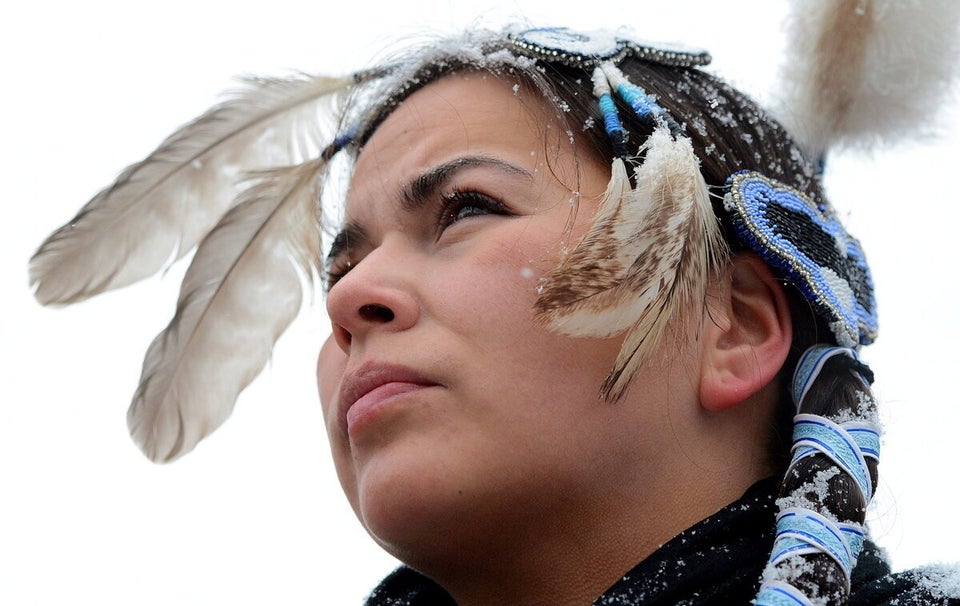In the 1870s, a federal fire sale -- 160 acres of land in exchange for $10 and a pinky-sworn promise to farm it -- saw Canada's settlement frontier explode west of Lake Superior. Over the next 60 years, more than 470,000 square kilometres of prairie land was given away to homesteading settlers like this, despite that land being occupied by Indigenous people.
Now, who'd like to talk government hand-outs?
The tensions between settlers and Indigenous peoples, who were perceived as "in the way" of settlement and farming, were cast through such settlement policies. These tensions echoed those from generations before but now, Indigenous peoples occupying desirable farmland were viewed as in the way of something bigger -- the creation of a nation itself. The meme sort of stuck. To complete Canada in the eyes of its builders required removing challenges to land sovereignty and development -- yeah, that'd be Indigenous people -- and assimilating them into the broader (read non-Indigenous) system. All for their own good of course.
In the wake of Idle No More and its push for mainstream Canadians to understand their history, it should be clear how badly this country's many attempts to assimilate Indigenous peoples have worked. But is it? Assimilation is Canada's most spectacular flop, but the refusal amongst its many believers to ignore the lessons of history remains unparalleled.
It's time we're offered new ideas. But some clearly don't think so.
"The great challenge of native policy in the 21st century," wrote one newspaper pundit, "will be to integrate natives into the larger economy that is based in Canadian population centres." Following the leaked Attawapiskat audit, the same writer opined that the community had lost its economic right to exist.
Integrate is the new code word for assimilate. Indeed, another columnist, claiming that too many First Nations people today live in a "dream palace" of belief that building a better future will come through a sovereign, more separate existence, argued that only those indigenous communities that have "decided collectively to integrate to varying degrees with the majority cultures" have found a way out of the "spirals of dependency."
Not to be left out, the Canadian Taxpayers Federation suggested that Canada needs a new approach with indigenous peoples, "one that treats all Canadians the same ..." Of course, this "new" approach of assimilation through equality was tried by guys named Chrétien and Trudeau, back in 1969. It didn't go so well.
Aside from the dangers of falling into a non-stop argument about identity politics, it's time to ask: How does assimilationist doctrine remain a viable idea in 2013? Lessons of its many historic failures are rife. Assimilation of First Nations peoples has been attempted intellectually, with residential schools "teaching" 150,000 indigenous children between the 1870s and 1996, when the last school closed.
Prime Minister Stephen Harper apologized for the residential school policy, calling it a "sad chapter" in Canada's history.
Thanks to Idle No More, and the widescale non-indigenous reaction to it, we can finally see that the chapter has yet to conclude.
Assimilation of indigenous peoples in Canada been attempted spiritually (missionaries), culturally (the banning of ceremonies through the Indian Act), politically (the imposing of the band and council system), and economically (far too many examples to list). None have been successes. All, in the language of today, are a fail.
Further, each time assimilationist policies are proposed as a federal law -- from the 1969 Liberal White Paper, to today's bill C-45 -- the result is nation-wide resistance from indigenous nations.
And yet, somehow, the lesson seems to remain unlearned. Idle No More takes to the streets, demanding an assimilationist policy be dropped. The intellectual brain trust responds by proposing assimilation be accelerated. The country, in turn, remains a divided mess.
The reason assimilation remains part of our discussion in 2013 is land. It all goes back to that 1870s fire sale. The Canadian project, its most vocal adherents believe, needs access to land and its resources to benefit the wider Canadian public. Assimilation is cultural, and intellectual, -- sure -- but at its root it's territorial. Were First Nations people already dispossessed of their land, assimilationists would have ceased to exist.
First Nations people would already be assimilated.
It's time we got rid of assimilation once and for all. To do so, it's time we talked about land and land rights. Sort of like what Idle No More is doing.
